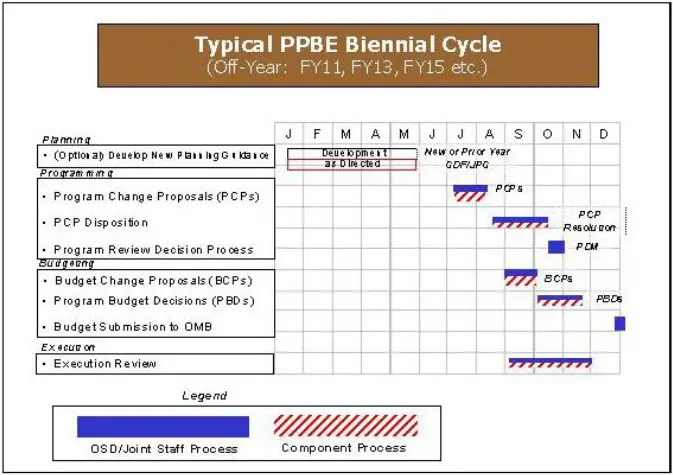Note: The DoD no longer uses On/Off Year funding.
In 2003, the DoD adjusted its planning, programming, and budgeting procedures to support a two-year cycle that results in two-year budgets. The revised process is described in Management Initiative Decision (MID) 913, dated May 22, 2003. The concept in MID 913 is consistent with the submission of a biennial DoD budget that is part of the President’s Budget request to Congress for even-numbered fiscal years (FY) (e.g., the FY 2010 President’s Budget, submitted to Congress in February 2009, contained justification material for both FY 2010 and FY 2011). In this cycle, the even-numbered years are called on-years, while the odd-numbered years are called off-years. [3]
On Year
The On-year (Even Years) will see the release of the Program Objective Memorandums (POM). Also released is Guidance for Development of the Force (GDF) and Joint Programming Guidance (JPG) covering Fiscal Year (FY) 2014-2019. In August of an even-numbered year, each Military Department and Defense Agency submits a combined POM/Budget Estimate Submission (BES) to the Secretary of Defense (SECDEF). [1]
See Memo for Procedures and Schedule for FY 2012-2016 Integrated Program/Budget Review, 9 Apr 10 for budget schedule for On-Year and changes.
Off-Year
The Off-Year (Odd Years) is focused on submitting budget changes to program baselines. The off-year review typically adjusts the remaining five years of the POM to reflect “fact-of-life” changes to programs. Incorporation of new requirements or major program changes is usually restricted to the regular, on-year POM process. Also, the Guidance for Development of the Force (GDF) and Joint Programming Guidance (JPG) are issued only at the discretion of the SECDEF. [2]
The below figure represents the PPBE Biennial Cycle for Off-Years. [3]

In practice, however, Congress only appropriates funds for the first year of the biennial budget request. Thus, amended budget justification must be submitted for the second year of the original biennial budget request so that Congress can appropriate the funds for that second year. This has caused PPBE to become in reality an annual process, although there are some significant differences in the “odd” year of the biennial cycle that are noted in the discussion of each PPBE phase as applicable
AcqLinks and References:
- [1] Website: ACQuipedia – On Year
- [2] Website: ACQuipedia – Off Year
- [3] Defense Acquisition Guidebook (DAG) – Chapter 1.2
- Memo for Procedures and Schedule for FY 2012-2016 Integrated Program/Budget Review, 9 Apr 10
Updated: 7/24/2021
